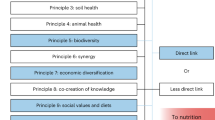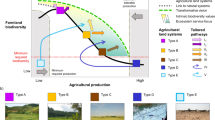Abstract
Landscape products link to low-input practices and traditional ecological knowledge, and have multiple functions supporting human well-being and sustainability. Here we explore seven landscape products worldwide to identify these multiple functions in the context of food commodification and landscape sustainability. We show that a landscape products lens can improve food systems by fostering sustainability strategies and standards that are place-sensitive, and as such can mitigate conflicts related to food production, social justice and the environment. Co-management strategies and information policies, such as certification, labelling, product information and raising of awareness could accelerate, incentivize and catalyse actions to support landscape products in the context of sustainability strategies.
This is a preview of subscription content, access via your institution
Access options
Access Nature and 54 other Nature Portfolio journals
Get Nature+, our best-value online-access subscription
$29.99 / 30 days
cancel any time
Subscribe to this journal
Receive 12 digital issues and online access to articles
$119.00 per year
only $9.92 per issue
Buy this article
- Purchase on Springer Link
- Instant access to full article PDF
Prices may be subject to local taxes which are calculated during checkout




Similar content being viewed by others
Data availability
All data related to the seven cases used as empirical evidence in this Perspective can be found in the Supplementary Information.
References
Fagerholm, N. et al. Perceived contributions of multifunctional landscapes to human well-being: evidence from 13 European sites. People Nat. 2, 217–234 (2020).
Riechers, M. et al. The erosion of relational values resulting from landscape simplification. Landsc. Ecol. 35, 2601–2612 (2020).
Guo, T., García-Martín, M. & Plieninger, T. Recognizing Indigenous farming practices for sustainability: a narrative analysis of key elements and drivers in a Chinese dryland terrace system. Ecosyst. People 17, 279–291 (2021).
Plieninger, T. et al. Dehesas as high nature value farming systems: a social-ecological synthesis of drivers, pressures, state, impacts, and responses. Ecol. Soc. 26, 23 (2021).
Polyxeni, N. S. et al. Chemical pesticides and human health: the urgent need for a new concept in agriculture. Front. Public Health 4, 148 (2016).
Flinzberger, L., Zinngrebe, Y. & Plieninger, T. Labelling in Mediterranean agroforestry landscapes: a Delphi study on relevant sustainability indicators. Sustain. Sci. 15, 1369–1382 (2020).
Salzman, J. et al. The global status and trends of Payments for Ecosystem Services. Nat. Sustain. 1, 136–144 (2018).
Strategy for Sustainable Food Systems, MeaDRI (MAFF, 2021); https://www.maff.go.jp/e/policies/env/env_policy/meadri.html
Thompson, C. J. & Coskuner-Balli, G. Enchanting ethical consumerism: the case of community supported agriculture. J. Consum. Cult. 7, 275–303 (2007).
Meemken, E.-M. et al. Sustainability standards in global agrifood supply chains. Nat. Food 2, 758–765 (2021).
Gardner, T. A. et al. Transparency and sustainability in global commodity supply chains. World Dev. 121, 163–177 (2019).
García-Martín, M. et al. Linking food systems and landscape sustainability in the Mediterranean region. Landsc. Ecol. 36, 2259–2275 (2021).
A Sustainable Food System for the European Union (SAPEA, 2020); https://sapea.info/topic/food/
Hölting, L. et al. Measuring ecosystem multifunctionality across scales. Environ. Res. Lett. 14, 124083 (2019).
Vivero-Pol, J. The idea of food as commons or commodity in academia. A systematic review of English scholarly texts. J. Rural Stud. 53, 182–201 (2017).
Al-Sayed, L. & Bieling, C. Food-related well-being in times of crisis: conceptual considerations and empirical findings for Syrian refugees in Germany. J. Migr. Health 1–2, 100005 (2020).
Block, L. G. et al. From nutrients to nurturance: a conceptual introduction to food well-being. J. Public Policy Mark. 30, 5–13 (2011).
Frei, B. et al. A brighter future: complementary goals of diversity and multifunctionality to build resilient agricultural landscapes. Glob. Food Secur. 26, 100407 (2020).
Jackson, P. et al. Food as a commodity, human right or common good. Nat. Food 2, 132–134 (2021).
Wu, J. Landscape sustainability science (II): core questions and key approaches. Landsc. Ecol. 36, 2453–2485 (2021).
Belton, B., Reardon, T. & Zilberman, D. Sustainable commoditization of seafood. Nat. Sustain. 3, 677–684 (2020).
Sayer, J. et al. Ten principles for a landscape approach to reconciling agriculture, conservation, and other competing land uses. Proc. Natl Acad. Sci. USA 110, 8349–8356 (2013).
Hedberg, R. C. & Zimmerer, K. S. What’s the market got to do with it? Social-ecological embeddedness and environmental practices in a local food system initiative. Geoforum 110, 35–45 (2020).
Maskell, L. C. et al. Exploring relationships between land use intensity, habitat heterogeneity and biodiversity to identify and monitor areas of High Nature Value farming. Biol. Conserv. 231, 30–38 (2019).
le Polain de Waroux, Y. & Lambin, E. F. Niche commodities and rural poverty alleviation: contextualizing the contribution of argan oil to rural livelihoods in Morocco. Ann. Assoc. Am. Geogr. 103, 589–607 (2013).
Ibarrola-Rivas, M.-J. et al. Telecoupling through tomato trade: what consumers do not know about the tomato on their plate. Glob. Sustain. 3, E7 (2020).
Zhang, W. et al. Ecosystem services and dis-services to agriculture. Ecol. Econ. 64, 253–260 (2007).
Díaz, S. et al. Assessing nature’s contributions to people. Science 359, 270–272 (2018).
Ghazoul, J., Garcia, C. & Kushalappa, C. G. Landscape labelling: a concept for next-generation payment for ecosystem service schemes. For. Ecol. Manag. 258, 1889–1895 (2009).
Fish, R., Church, A. & Winter, M. Conceptualising cultural ecosystem services: a novel framework for research and critical engagement. Ecosyst. Serv. 21, 208–217 (2016).
Rundgren, G. Food: from commodity to commons. J. Agric. Environ. Ethics 29, 103–121 (2016).
Petrini, C. Slow Food: The Case for Taste (Columbia Univ. Press, 2003).
Ives, C. D. et al. Reconnecting with nature for sustainability. Sustain. Sci. 13, 1389–1397 (2018).
Abson, D. J. et al. Leverage points for sustainability transformation. Ambio 46, 30–39 (2017).
Soga, M. & Gaston, K. J. Extinction of experience: the loss of human–nature interactions. Front. Ecol. Environ. 14, 94–101 (2016).
Saito, O. (ed.) Sharing Ecosystem Services: Building More Sustainable and Resilient Society (Science for Sustainable Societies, Springer, 2020).
Rogers, D. S. et al. A vision for human well-being: transition to social sustainability. Curr. Opin. Environ. Sustain. 4, 61–73 (2012).
Boogaard, B. K., Oosting, S. J. & Bock, B. B. Defining sustainability as a socio-cultural concept: citizen panels visiting dairy farms in the Netherlands. Livest. Sci. 117, 24–33 (2008).
Chen, X. et al. Linking social norms to efficient conservation investment in payments for ecosystem services. Proc. Natl Acad. Sci. USA 106, 11812–11817 (2009).
Pretty, J. Social capital and the collective management of resources. Science 302, 1912–1914 (2003).
Kim, J. Social dimension of sustainability: from community to social capital. J. Glob. Schol. Mark. Sci. 28, 175–181 (2018).
Hickey, G. et al. Quantifying the economic contribution of wild food harvests to rural livelihoods: a global-comparative analysis. Food Policy 62, 122–132 (2016).
Bowen, S. & De Master, K. New rural livelihoods or museums of production? Quality food initiatives in practice. J. Rural Stud. 27, 73–82 (2011).
Daviron, B. & Vagneron, I. From commoditisation to de-commoditisation…and back again: discussing the role of sustainability standards for agricultural products. Dev. Policy Rev. 29, 91–113 (2011).
Debonne, N. et al. Agency shifts in agricultural land governance and their implications for land degradation neutrality. Glob. Environ. Change 66, 102221 (2021).
Zimmerer, K. S., Lambin, E. F. & Vanek, S. J. Smallholder telecoupling and potential sustainability. Ecol. Soc. 23, 30 (2018).
Farm to Fork Strategy: For a Fair, Healthy and Environmentally-Friendly Food System (European Commission, 2020); https://eur-lex.europa.eu/resource.html?uri=cellar:ea0f9f73-9ab2-11ea-9d2d-01aa75ed71a1.0001.02/DOC_1&format=PDF
“Génération Green 2020-2030”: Une Stratégie Consacrant la Vision Royale d’un Secteur Agricole Résilient et Durable (MAP, 2021); https://www.mapnews.ma/fr/actualites/economie/g%C3%A9n%C3%A9ration-green-2020-2030-une-strat%C3%A9gie-consacrant-la-vision-royale-dun-secteur
Flinzberger, L. et al. EU-wide mapping of ‘Protected Designations of Origin’ food products (PDOs) reveals correlations with social-ecological landscape values. Agron. Sustain. Dev. 42, 43 (2022).
Plieninger, T. et al. Fostering biocultural diversity in landscapes through place-based food networks: a ‘solution scan’ of European and Japanese models. Sustain. Sci. 13, 219–233 (2018).
Acknowledgements
The research here presented is part of the LANDSCAPE CHAINS project funded by the German Research Foundation, DFG, through grant number 426675955. We acknowledge the important contribution to this research of the local communities, authorities and partners from the seven case studies. We thank M. Reinhard-Kolempas for her contribution to the case study descriptions included in the Supplementary Information. All figures have been designed by J. Traudes, www.have-a-look.de. The following co-authors acknowledge individual support of their research: T.P.: German Research Foundation (DFG) through the Sustainable Food Systems Research Training Group (RTG 2654). J.M.-R.: FCT—Foundation for Science and Technology (Portugal) under the project UIDB/05183/2020. U.D.: MAVA Foundation (grant number 20009). O.S.: Japan Science and Technology Agency, e-Asia JRP, ‘Integration of traditional and modern bioproduction systems for a sustainable and resilient future under climate and ecosystem changes (ITMoB)’. J.L.: US National Science Foundation (grant number 1924111) and Michigan AgBioResearch. T.K., T.D.: MAVA Foundation through the Terra Lemnia project, M6 OAP 2017-2022 on Cultural Landscapes. C.Q.-S.: European Union’s Horizon 2020 research and innovation programme under the Marie Sklodowska-Curie Action (MSCA) grant agreement number 101031168.
Author information
Authors and Affiliations
Contributions
All authors have contributed to this Perspective through an iterative process of several online workshops and meetings from September 2020 to July 2021, where the idea of the paper was defined, discussed and revised. T.P. provided the original idea and M.G.-M. has coordinated the process. J.M.-R., K.S.Z., M.J.I.-R., M.E.F.G., O.S., T.K., T.D. and U.D. have each contributed a case study.
Corresponding authors
Ethics declarations
Competing interests
The authors declare no competing interests.
Peer review
Peer review information
Nature Food thanks Lisanne Hölting, Joachim Maes and Albert Norström for their contribution to the peer review of this work.
Additional information
Publisher’s note Springer Nature remains neutral with regard to jurisdictional claims in published maps and institutional affiliations.
Supplementary information
Supplementary Information
Supplementary Boxes 1–7 and Supplementary Cases 1–7.
Rights and permissions
Springer Nature or its licensor holds exclusive rights to this article under a publishing agreement with the author(s) or other rightsholder(s); author self-archiving of the accepted manuscript version of this article is solely governed by the terms of such publishing agreement and applicable law.
About this article
Cite this article
García-Martín, M., Huntsinger, L., Ibarrola-Rivas, M.J. et al. Landscape products for sustainable agricultural landscapes. Nat Food 3, 814–821 (2022). https://doi.org/10.1038/s43016-022-00612-w
Received:
Accepted:
Published:
Issue Date:
DOI: https://doi.org/10.1038/s43016-022-00612-w
This article is cited by
-
Narratives of land abandonment in a biocultural landscape of Spain
Regional Environmental Change (2023)
-
Embedding plural values in value chains to enhance sustainability in the management of cork oak landscapes
Landscape Ecology (2023)
-
Longitudinal analysis of home food production and food sharing behavior in Japan: multiple benefits of local food systems and the recent impact of the COVID-19 pandemic
Sustainability Science (2023)



